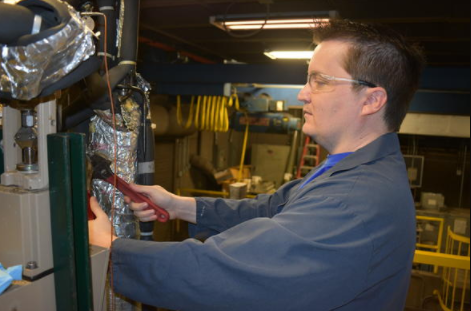CAER Grant Uses Acoustic Technology to Reduce CO2 Capture Cost

A University of Kentucky Center for Applied Energy Research (CAER) team has received a grant to develop a novel, acoustic-assisted process that would make capturing carbon dioxide (CO2) from coal-fired power plants and industrial facilities significantly less expensive. The grant was funded by the University Coalition for Fossil Energy Research (UCFER), a U.S. Department of Energy (DOE) supported program.
This project will build upon CAER’s world-renowned carbon dioxide capture research. CAER’s CO2 system employs an absorption column and utilizes solvents to capture carbon dioxide. Essentially, the solvent absorbs the CO2, allowing the system to extract and remove the carbon dioxide from the combustion flue gas at a fossil fuel-based energy production plant.
CAER’s Bradley Irvin, principal investigator (PI) on this research project, proposes that a novel intensification device — acoustic-driven packing material — will increase the mass transfer coefficient in the absorption column. This device transmits high frequency acoustic energy, at resonance, into the packing material of an absorber column which will cause that material to vibrate and become a transmitter of the incident acoustic energy. Solvent in contact with the vibrating packing material will oscillate at similar wave parameters to the source of acoustic energy. These high frequency traveling waves cause acoustic streaming and micro turbulence which improves absorption rate.
Kunlei Liu, associate director for research at CAER and co-PI on this project says that the successful integration of this technology into a full-scale CO2 capture process at a power plant has the potential for major capital cost savings. Current projections estimate that a 60-foot packed absorber column would cost $85 million. This project hopes to improve the mass transfer in the absorber column by 30%, which could result in a 26% capital construction savings.
“We have seen promising results in our proof of concept and laboratory testing phases,” said Irvin, associate research scientist at CAER. “Not only for CO2 capture but for field of process engineering. Being novel, acoustic driven packing material has several hurdles in its developmental path before it can be established as a proven technology. It must demonstrate effectiveness at increasing mass transfer in a relevant environment. It must be shown to be scalable and its overall process enhancements must outweigh its costs. We hope this project will move this technology forward.”
CAER will be working with DOE’s National Energy Technology Laboratory on the effectiveness of the technology, its scalability, and additional applications. In addition, MPI Ultrasonics will assist in overcoming the technical problems associated with the acoustic setups encountered during the previous phases of development.
UCFER, which is based at Penn State University, was established in 2015 to advance basic and applied fossil energy research through mechanisms that promote collaboration among the U.S. Department of Energy and the universities that are members of the coalition by the coordination of research and the sharing of data.
Credits
Dave Melanson (Center for Applied Energy Research)

